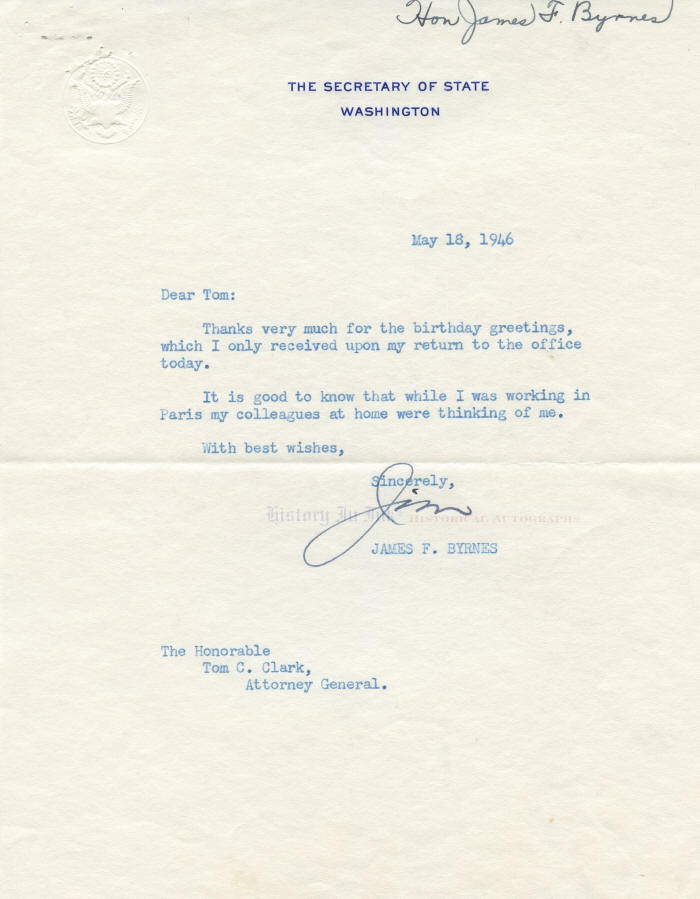1222131
James F. Byrnes
Scroll down to see the image of the item below the description
From the personal collection of Supreme Court Justice Tom C. Clark
Byrnes appreciates “my colleagues at home . . . thinking of me” during his work
at the second meeting of the Council of Foreign Ministers in Paris
James Francis Byrnes, 1882–1972. Associate Justice, United States Supreme Court, 1941–1942; Secretary of State, 1945–1947. Typed Letter Signed, Jim, one page, 7” x 9”, on blind-embossed stationery of The Secretary of State, Washington, [D.C.], May 18, 1946.
Byrnes, one of the most powerful men in American domestic and foreign policy during the 1940s, writes this letter after returning home from some three weeks in Paris, where he attended the second meeting of the Council of Foreign Ministers. He thanks then-Attorney General Tom C. Clark for birthday greetings. He writes, in full: “Thanks very much for the birthday greetings, which I only received upon my return to the office today. / It is good to know that while I was working in Paris my colleagues at home were thinking of me.”
President Harry S. Truman appointed him Secretary of State on July 3, 1945, less than three months after becoming President. Under the law that existed at that time, the Secretary of State was the next in line to become President, given the vacancy in the office of Vice President. Truman wanted a potential successor who had elected political experience, and the sitting Secretary of State, Edward Stettinius, had none.
But Byrnes had done virtually everything: He had served as a Representative, 1911–1925, and then Senator, 1931–1941, from South Carolina. Partially in reward for his support on many issues, President Franklin D. Roosevelt appointed him to the Supreme Court in July 1941, where he served for 15 months before he resigned to accept appointment as the Director of the Office of Economic Stabilization, 1942–1943. FDR then made him Director of the Office of War Mobilization, where he served from 1943 until Truman appointed him Secretary of State. In 1944, with the vice presidency up for grabs, Truman went to the Democratic National Convention in Chicago pledged to nominate and support Byrnes for Vice President—a job that ultimately fell to Truman himself. After the election, Byrnes accompanied Roosevelt to the Yalta Conference in January 1945, where Byrnes, who was accomplished in shorthand, took copious notes. Once Truman became President, he relied on Byrnes for information on Rooseveltʼs dealings with the Soviet Union.
Byrnesʼs time on the Supreme Court was short, just under 15 months, and his record as a Justice was sparse. He was the last Justice who had passed the bar by reading law in a law office rather than attending law school. He left the Court both in recognition that he was not suited to its cloistered, intellectual demands and out of a desire to be at the center of action in a nation at war.
The Paris meeting to which Byrnes refers in this letter followed up on the foreign ministersʼ meeting in London in September 1945. The ministers agreed at Moscow in December 1945 to meet again and attempt to resolve differences over the peace treaty with Italy following the end of World War II. Reporting on the Paris conference, Byrnes said that the “progress made toward peace at the Paris meeting . . . was disappointingly small in light of the expectations we had” in Moscow. “The Ministers did come to Paris seriously intending to pave the way for a peace conference. We differed considerably on a number of fundamental points,” he said, but the ministers at least distilled their differences and the weight that the various members attached to them.
Byrnes and Truman later had a falling out over what Truman perceived to be Byrnesʼs effort to formulate U.S. foreign policy himself. Truman and others sensed that Byrnesʼs resentment over not being Rooseveltʼs successor led him to disrespect Truman. Byrnes resigned as Secretary of State in 1947, and Truman appointed General George C. Marshall to replace him. Byrnes subsequently served a term as Governor of South Carolina, 1951–1955, before retiring.
This letter is in fine condition. Byrnes has signed it in blue-black fountain pen. The letter has staple holes at the upper left, affecting the embossed State Department seal, and there is a notation in another hand identifying Byrnes at the upper right margin. The single horizontal mailing fold barely touches the “J” in Byrnes’s signature.
Provenance: This letter comes from the personal collection of Justice Tom C. Clark, who served on the Supreme Court from 1949 until 1967. Justice Clark collected the autographs of Supreme Court Justices dating back into the 19th Century. We are privileged to offer a number of items from this collection.
Unframed.
This item is sold.








